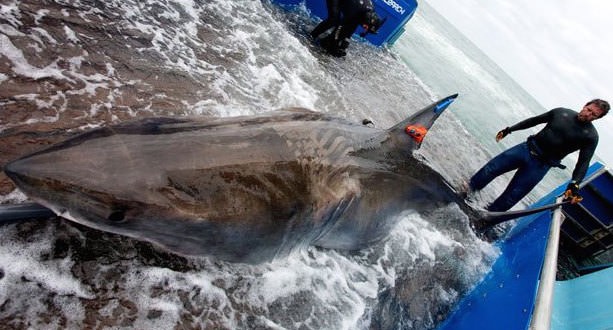It’s the time of year everyone seems to be on a busy schedule — and that goes for great white sharks, too.
A great white shark named Lydia, which is being tracked by researchers, has become something of a social media celebrity, with a Twitter account tracking her progress.
Fischer, the founding chairman and expedition leader of Ocearch, has watched Lydia swim far and wide since she was last near this province. He said the 2,000-pound shark has a case of wanderlust.
“She’s travelled over 25,000 miles in less than two years. She’s connected the dots between Florida and the southeast of Newfoundland, and kind of excited everybody over in Europe there when she crossed the mid-Atlantic ridge … and then down south past the Azores off northwest Africa and back to the southeast,” he said.
“Now she seems to be repeating that pattern almost to the day.”
Of the five tagged sharks Ocearch is tracking, Lydia has made it the farthest north. Fischer said since Ocearch has only been tracking them for a couple of years, it’s impossible to say whether this is a normal occurrence.
“You know, we have to tag more sharks to determine what is normal. Right now we’ve got five sharks tagged in the Atlantic, and only three of them are really good swimmers,” he said, adding Lydia is one of those three.
“We’re getting the first patterns ever.”
Acoustic tags have tracked great white sharks to the waters off Newfoundland in the past, he said, but those tags didn’t provide as much information to researchers as the spot tags the team is using now.
“We never really had any track of how they were getting there, or where they were coming from,” Fischer said.
Fischer described the massive sharks as the lions of the ocean, which eat whatever they want and follow life, foraging. He said the fact they’re travelling near this province shouldn’t frighten people — there’s no history of a shark problem here — and if anything, people should be excited that their patterns are being tracked.
“I think everybody needs to be celebrating the fact that, for the first time in history, we’re solving the puzzle of these sharks that are going to create the future abundance of the ocean. If there is not a bunch of great white sharks thriving, there’s not going to be a bunch of fish for our great-grandchildren to eat,” he said. “We’re seeing the return of the great predator, which means, hopefully, we can get the ocean trending in the right direction.”
He said Lydia is probably foraging now in the waters off Newfoundland.
“Last year she came right up into the beach (by Marystown). I wouldn’t be surprised if you see her go and poke her nose around in that very same exact spot — we’ve seen that many times before,” he said.
He said it’s interesting and exciting to see Lydia back near Newfoundland — something he didn’t expect.
“I thought I was getting a handle on what Lydia was doing,” he said. “She’s really confusing me right now.”
Agencies/Canadajournal
 Canada Journal – News of the World Articles and videos to bring you the biggest Canadian news stories from across the country every day
Canada Journal – News of the World Articles and videos to bring you the biggest Canadian news stories from across the country every day




Follow Ocearch: http://www.ocearch.org/